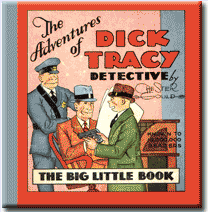As a Museum Educator at the Walt Disney Family Museum, part of my job is to facilitate student visits to the museum. When I lead groups of students through the galleries, I often try to relate the story and the artifacts in terms of things they know and understand. I sometimes ask younger visitors who they think the biggest celebrity in the United States is today. They often provide examples of famous athletes and popular singers, (think Michael Phelps and Justin Bieber). Using these examples as a comparison, I tell the students that during the 1930s, the popularity of Mickey Mouse rivaled that of the super celebrities of today.
 Mickey Mouse’s popularity is especially apparent in the amount of merchandising produced during the 1930s. Gallery 2b exhibits many examples of products featuring the face of Mickey Mouse, including watches, dolls, and even an automobile hood ornament. A number of books and comics were published with stories about the mischievous mouse, such as a popular series of books for younger readers known as Big Little Books.
Mickey Mouse’s popularity is especially apparent in the amount of merchandising produced during the 1930s. Gallery 2b exhibits many examples of products featuring the face of Mickey Mouse, including watches, dolls, and even an automobile hood ornament. A number of books and comics were published with stories about the mischievous mouse, such as a popular series of books for younger readers known as Big Little Books.
The Big Little Book series was published by the Wisconsin-based Whitman Publishing Company beginning in 1932. The oxymoronic title referred to the large amount of story and enjoyment experienced by reading a disproportionately smaller book. The original design measured just 3⅝’’ wide, 4½’’ high, and 1½’’ thick. The books were typically around 432 pages in length, and a captioned picture appeared next to each page of text.
Big Little Books were initially sold for just 10¢ and were very popular with younger readers. The books were generally sold at five-and-dime variety stores such as Woolworth’s.
Big Little Books touched on a wide variety of stories and subject matter, with many being adapted from popular comic strips, movies, and radio programs. A few of the books featured original stories, and several were non-fiction biographies intended for younger readers.
 The first Big Little Book was The Adventures of Dick Tracy, published in 1932. However, one of the most popular characters in the series was none other than Mickey Mouse, who first graced the pages of Big Little Books in 1933. Mickey appeared in more Big Little Books than any other character, and a few of the books are valued collectibles today. Some of Mickey’s earliest Big Little Book adventures included Mickey Mouse: the Mail Pilot, Mickey Mouse Sails for Treasure Island, and Mickey Mouse the Detective.
The first Big Little Book was The Adventures of Dick Tracy, published in 1932. However, one of the most popular characters in the series was none other than Mickey Mouse, who first graced the pages of Big Little Books in 1933. Mickey appeared in more Big Little Books than any other character, and a few of the books are valued collectibles today. Some of Mickey’s earliest Big Little Book adventures included Mickey Mouse: the Mail Pilot, Mickey Mouse Sails for Treasure Island, and Mickey Mouse the Detective.
Mickey Mouse was not the only popular Disney character to be featured in the Big Little Books. Donald Duck, Dumbo, and Bambi also starred in adventures of Big Little proportions.
During the mid 1930s, Whitman began publishing another series of compact books with a modified design. These soft cover premiums were produced for specific stores and companies, and were often shorter in length. The books continued to utilize the Big Little Book format of a captioned picture accompanying each page of text, and were eventually printed in color. Some of Mickey Mouse’s adventures were adapted to this format as well.
Following the success of the original Whitman Big Little Books, other publishing companies put similar products on the market. The compact, economical design of the books was an attractive feature to publishers during the Great Depression.
Mickey Mouse’s appearances in Big Little Books demonstrate one of the many ways he transcended the screen and became embedded into the heart and culture of the United States. His plucky personality and determined spirit made him an icon of the 1930s, when Americans sought to escape the challenges of the Depression into the fancy free worlds of books and motion pictures.
Join us at The Walt Disney Family Museum on Saturday, August 25 for a special program hosted by Disney historian J.B. Kaufman about the history of Disney’s Big Little Books and how they were assembled. Like the books, the program promises to pack a lot of punch into just one afternoon! It is definitely not to be missed.

Alyssa Carnahan
Museum Educator
[Images — Top: Second publishing of the Mickey Mouse Big Little Book. Courtesy The Walt Disney Family Museum. Bottom: First edition of The Adventures of Dick Tracy (1932). Photo courtesy BigLittleBooks.com.]
